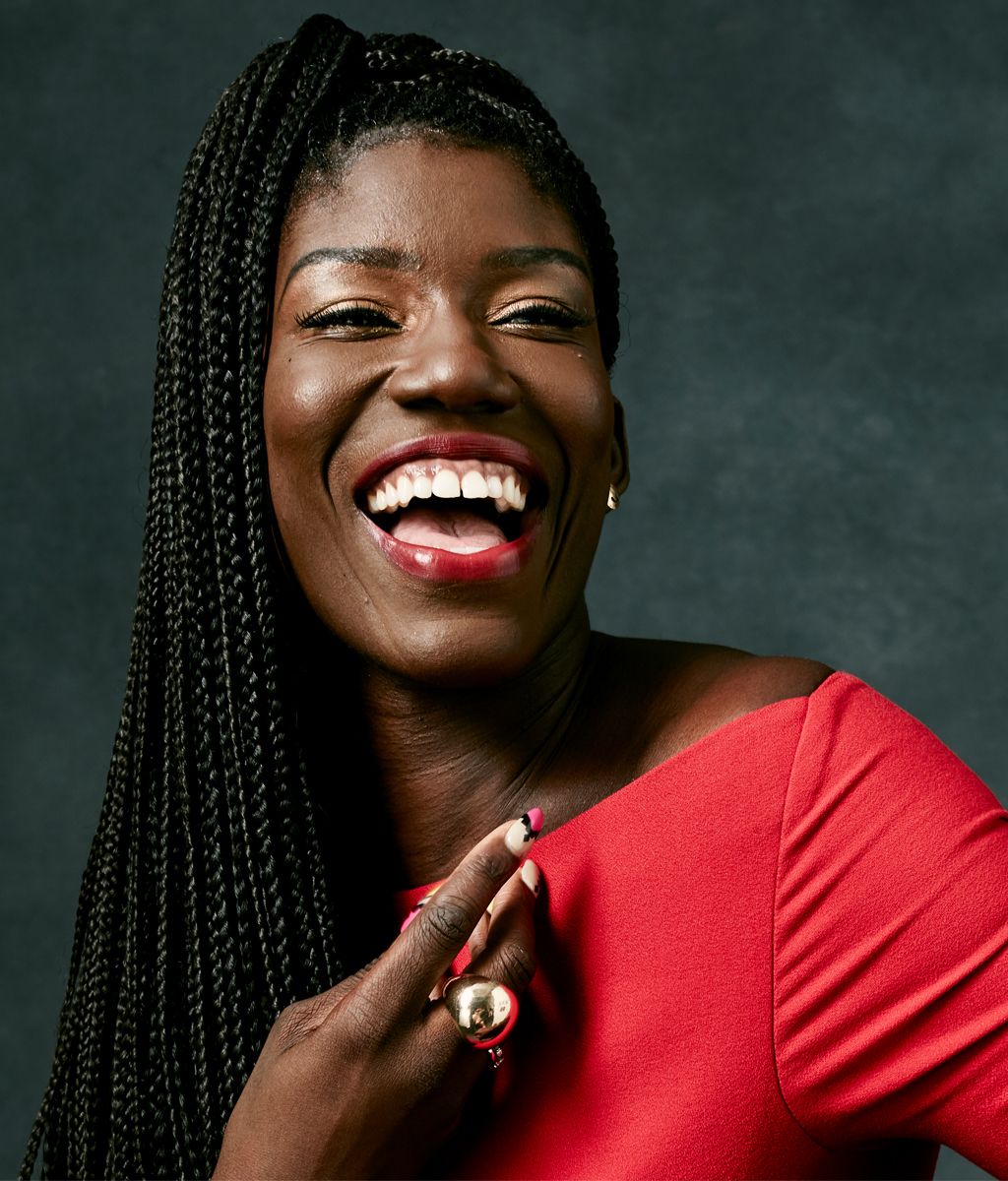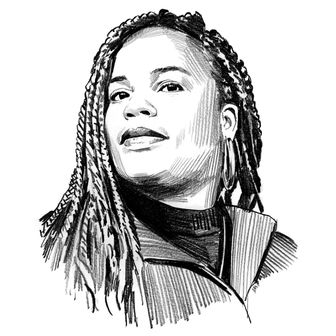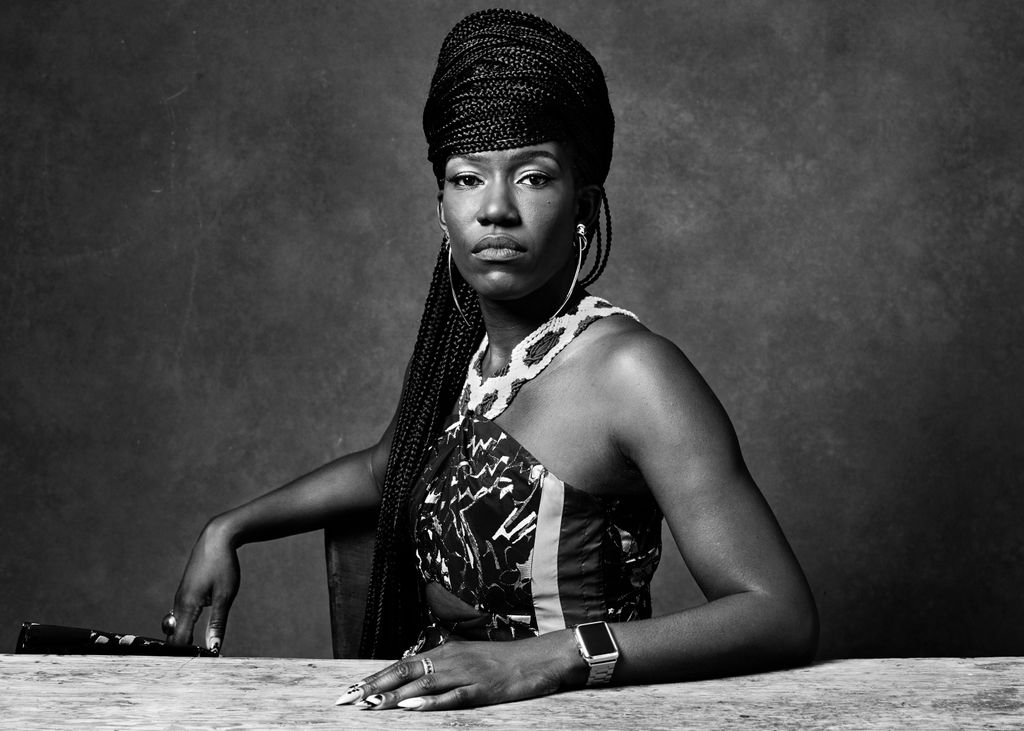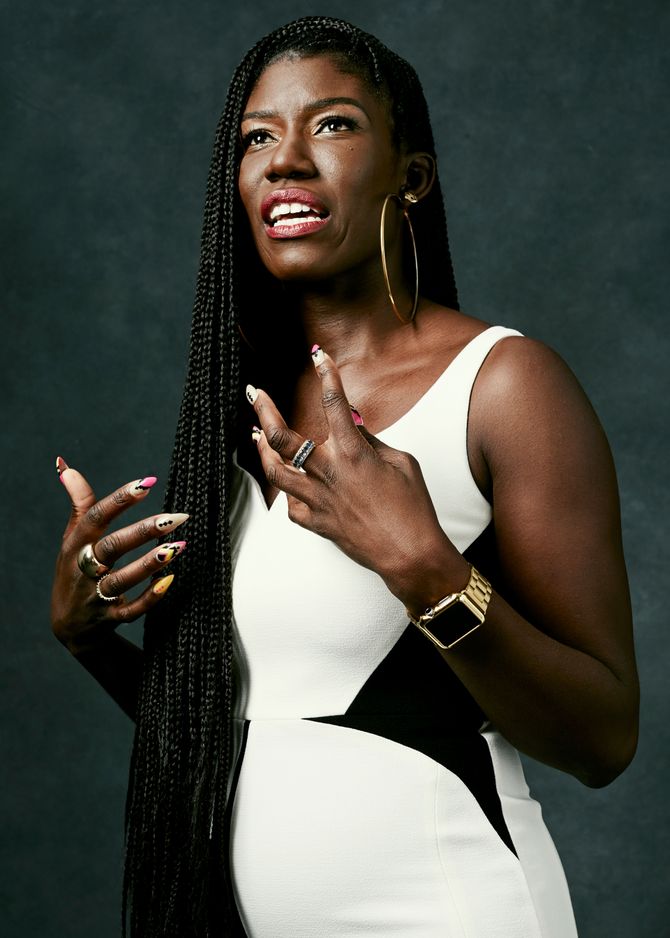It’s a standard San Francisco morning — freezing and foggy — and I’m shivering on a North Beach street, an internal debate raging: should I take a Lyft or re-download the Uber app? I, like 200,000 others, deleted Uber in January, when the company continued to do business at JFK while New York City taxi drivers were on strike, protesting Trump’s immigration ban. But is it poor form to take a Lyft to Uber offices, where I’m due to meet Bozoma “Boz” Saint John, the new chief brand officer? Also up for debate: whether her recent appointment is enough to make me think differently about Uber, ethically, morally, and personally.
I summon a Lyft.
Currently Uber’s brand is “crisis.” Or, even more accurately, “we fucked up, but gee we’re trying to get better!” In 2017, the company got caught in a storm of bad press: there was the aforementioned #deleteuber campaign, then ex-engineer Susan Fowler published a blog post about the sexual harassment and gender discrimination she’d suffered during her employment at the company, then the New York Times published a detailed article about the aggressively sexist frat-tastic workplace culture, then there was the Google lawsuit, then the video of CEO Travis Kalanick yelling at an Uber driver, then Kalanick’s resignation — in what felt like just a few months, the brand became so closely associated with corporate sins that nobody (or at least most women, millennials, and people of color) wanted to touch it.
Saint John was hired to turn Uber back into a brand that people love, the kind of herculean task that seems to require some sort of magic wand in addition to her long list of impressive qualifications. (Former head of Music and Entertainment Marketing at PepsiCo and head of marketing for Apple Music.) But what Uber might be betting on is not a magic wand, but a magic identity, in a moment when identity politics reigns.
“It’s an incredibly strategic and smart move from them, for a number of reasons,” explains Arielle Goren, former Lead of Special Projects for Policy and Communication at Uber. “Obviously: her being a woman of color and an immigrant” — Saint John is from Ghana — “I think she also just brings a certain kind of cool factor that’s been missing. It’s a bunch of brogrammers who wouldn’t know cool if it shot them in the arm. She fixes that.”
After her hire was announced in June, the strategy seemed to be working. Saint John was awash in buzz. “Is this the Woman Who Will Save Uber?” asked the New York Times in one of two overwhelmingly positive pieces exalting her as the savior of the company. The paper described how her new role put her alongside the CEO, where she’d be “helping steer from the passenger seat, stilettos and speakers on.” She went hard on the glossy lifestyle magazine circuit — Glamour, Cosmopolitan, Teen Vogue. She put on a red dress, red lipstick, and gold hoops, and charmed on an interview on CBS This Morning. Gayle King called her a “firecracker.”
The PR push put her forward as a sign of progress within the company. Every article and interview offered an implied “but we have a black friend!” defense, and a certain “Yoo hoo, women, minorities, and other people skeptical about the company, please look over here! Not at Travis” subtext. Plus, Saint John was a respite from Uber’s punishing news cycle. She was a new, friendly, relatable figurehead — a single mom, a fashion-plate, a woman to watch — as the search for a new CEO dragged on. Finally, after months on the road and in the public eye, she was meeting with me during her first full day at Uber’s headquarters in San Francisco. And after weeks of negotiations and rules and guidelines about what I can include and how much unchaperoned time I’ll get (none), I’m finally here, and — to borrow her favorite Instagram hashtag (#watchmework) — I get to watch her work, and see how she intends to accomplish what she was hired to do: make Uber seem like … if not exactly a good company, then at least one less deserving of ire. Good luck.
I almost miss Saint John’s entrance at Uber’s antiseptic but start-up-cliché-filled office (iPad security check in, free Philz coffee, open plan). A feat, given she’s five-foot-eleven, even without the five-inch, gold, winged Giuseppe Zanotti sandals she’s wearing. She constantly stands out in a land of button-ups and sensible casual businesswear; and today, she’s in a green fashion sweatshirt and matching jog-pants, along with pristine black braids woven into a crown.
“Ayyyy!” Saint John says, as I approach, dipping back with her arms wide open for a hug. “I like your braids! Look at us with the matching braids,” she says touching my hair, and flipping hers. I’m already caught up in her charisma. We’re just two black ladies being loud, flipping our hair in an otherwise silent, white, male office. Where’s Uber’s chief of diversity? This is an ad.
She immediately launches into a boisterous story about almost missing her flight this morning. Saint John lives in L.A. with her 8-year-old daughter, La’el. She usually commutes on the same 6:06 flight from L.A. to San Francisco, and she’ll head back at the end of the day, to be there in time for a special Back to School dinner with La’el. Of course — and here’s the Uber tie-in, don’t worry, she always finds the angle — the same Uber driver, Israel, always picks her up at 4 a.m. and gets her there on time. Today she gave him the wrong terminal, though, ended up having to run across twelve lanes of LAX traffic in those five-inch sandals. But she made it.
“I believe in manifesting the words that are coming out of my mouth,” she says. “I’m very careful with what I say because the intention is then out in the universe.” This is how she believes she got through the airport: by manifesting her will to get to work.
Today, I’ll observe Saint John as she addresses all of the employees during the company’s weekly all-hands “fireside chat.” Then we’ll attend two meetings: a “driver forward” meeting, and an update from Saint John’s Branding and Vision team, followed by lunch in Uber’s cafeteria. Everything, down to walking, is on an agenda.
“I plan breaks — I mean, you have to pee!” Saint John says.
“Five minutes only,” assistant Jen jokes. I think.
“I’m so excited about today, because I keep going around to the offices around the country. I had the best time.” Saint John says as she’s leading me to the all-hands meeting. We make a wrong turn; she’s still learning the office. “I went to Toronto — Hey Marshall!”
“He-hey! How are you,” says a stunned tall white guy in a gray T-shirt, confused to be recognized.
Saint John demurs when I call her a unicorn, because she doesn’t consider herself one, even if the rest of Silicon Valley does. She’s black and a single mother — her husband, Peter Saint John, died from Burkitt lymphoma in 2013 — with pedigree for days. Saint John was born in Ghana; she moved to Colorado Springs with her parents and her three younger sisters when she was 12, and frequently discusses how her mother and father (he a member of Ghanaian parliament, up until the 1981 coup d’état) made sure she felt connected to her African culture, even when she was one of few black people — well, anywhere she went. As if in preparation for the rest of her career, Saint John was captain of the cheerleading squad and the track team, and ran for student council with the Dr. Dre–inspired slogan “Ain’t Nothin but a Boz Thing,” and then went on to college at Wesleyan where she taught a class on Tupac Shakur as an undergraduate independent study. After stints at Spike Lee’s DDB and 12 years as the marketing head of Music and Entertainment at PepsiCo, she went to Apple in 2016. When she took the stage that year at their Worldwide Developers Conferences, Saint John was used to being the only black woman in a room, oozing charm, patiently explaining to white people how to be cool. This was especially clear when she tried to make the whole room dance to “Rapper’s Delight,” and turned out to be the only person who could keep the beat. Uber hired her in June after an eight-hour meeting between her, not-yet-ousted CEO Travis Kalanick, and board member Arianna Huffington. It wasn’t a job interview, per se, but she walked out with the CBO offer.
Saint John took the job not for the paycheck (though, obviously, there was the paycheck) but because it was such an exciting and scary challenge, she tells me, and she wanted to prove she could do it. “I thought it was a huge, huge mountain. I was intimidated by it, so I wanted to do it. It was just so big; I was like, how am I going to do it? All of a sudden you see. It’s like being in a little boat and being like, oh, I could row there.”
It’s easy to see why Uber wanted Saint John. She had a good track record at Apple, and made Apple Music seem more appealing just by being associated with it. Part of the appeal of Saint John is that she is always, unequivocally her vibrant self: in the office, on stage, in talks, on Instagram where she goes by @badassboz and has 80,000 followers. She loves high fashion: heels, enviable outfits from Chanel and Marni, and big jewelry. She’s cool. She often goes to concerts and awards shows with her daughter in tow. She has two phones, both with shamelessly, perfectly gaudy gold cases. She has Drake in her iPhone contacts. “I say bring your whole self to work,” she tells me. “This is the way I am. There’s no — I don’t know how to be anything else.”
Currently she’s being herself on stage during her portion of the all-hands meeting — someone has projected a loop of fireworks onto the screen behind her head; Uber is clearly excited about this. By now, Saint John has a pretty solid song and dance about what she is doing at this company, how she got the job, and how excited she is. It’s been rehearsed to perfection after so many months on the road. Today, she drops the remix, this time adding the new story she told me about Israel. Then it’s back to the preexisting track: sound-bytes about being up for the challenge, and the familiar hook about how excited she is to be part of the team, and into the final verse, the now famous story about bringing an Uber driver to a party where Iggy Pop did a concert. Everyone laughs when they are supposed to laugh, and claps when they are supposed to clap.
During the Q&A, she’s asked what brands are inspiring her right now, which results in the most illuminating thing she’s ever said about herself: “I’m such a brand nerd,” she says, before citing Jordan as her favorite brand. “I think it’s interesting how you can associate a creative brand with a human being and use some of the good qualities of the human being and make it like a really tangible product that a lot of people can love.” Saint John seems well aware that, if all goes well, her personal brand will be part of the cool-ification story for Uber, just like it was for Apple Music.
After the all-hands, a small circle of brown and black women come up to Saint John. “I was hired the week Travis Kalanick resigned,” one woman tells her. “My first week of actual work was when you started.” This woman, and the rest of the receiving line, tell Saint John how excited they are and how much it means to them that she is here in this position at this time. And, schedule be damned, she takes the time to connect with each woman — be it about earrings, a podcast, motherhood — in interactions that are warm and full of eye contact. I’m told explicitly I can include this moment, just in case I was considering not.
Five years ago, Marissa Mayer and Sheryl Sandberg were the figures that the Valley liked to point to as examples of progress. They were a distinct type of woman — chic in an Oscar de la Renta sheath-dress way, corporate, no-nonsense. Meyer had her Vogue spread; Sandberg launched a movement. Both believed in work as life (Meyer famously had a day care built so she could bring her child to work, and thus never leave the office). Now the desired brand is different. A woman like Saint John is what the Valley wants to be associated with — someone cool, nonwhite, non-corporate, real. And while there is nobody like Saint John, companies are still trying to make splashy hires: Apple hired Denise Young Smith as the VP of Diversity and Twitter has Candi Castleberry-Singleton as their VP of Diversity and Inclusion. And in order for more women of color to get hired, women of color have to get hired in leadership roles. But occasionally, there’s a sense that women in these prominent positions are shouldering the responsibility for distracting from messes they didn’t make. The companies that hire them understand their value in the public eye. I ask Saint John how she feels that the concept of tokenism comes up so often in conversations about her.
“I’m offended by that,” she says. “I’m offended because you wouldn’t ask anybody else that question. That takes away from my accomplishments; that takes away from what I’m capable of. If there were somebody else who had the accolades, who had the receipts, would you ask them that? It offends me at every level. I’m black and I’m a woman, and those are benefits in what I do. Excuse me. It’s a micro-aggression. Oh okay, so I am considered a token, does that mean the work I do is also token? It’s not. The work I’m doing is really important, and therefore no. I’m not. I reject that notion at all,” Boz leans into me, making impassioned eye contact, as if she’s talking to a friend who’s probably experienced the same exasperation. (Of course I have, Boz.)
And we’re walking!
“Hi Boss, we haven’t met yet,” says a member of the Driver Growth team. Actually, I can’t tell if he says “Hi Boss!” which would be incredibly cool and respectful, or “Hi Boz,” as in a mispronunciation of her nickname, which would be incredibly disrespectful.
Saint John, Momo, and I have settled around a rectangular table in a small conference room for the first of two meetings, and Saint John pulls out a composition notebook, eager to learn. I can’t tell who started using “tactile” first — Saint John or Momo — but now it’s time to see how Saint John plans to execute her ideas in tactile ways, and what the tactile applications of her vision will mean in a real, tactile way for drivers and users. Hopefully I will find out what this means later in the meeting. Meanwhile, Saint John is explaining that she doesn’t like the word “rebrand,” that she prefers to focus on helping the company evolve.
“I want to change the perception of this brand. By showcasing all of the complexity of what will actually humanize the brand. What are the stories we can tell? My hope is that from a very tactile level it changes the perception of what the brand is and get people back with us and we get new fans from being fans to being riders and we get people who are fans to be drivers,” she explains.
One way to do this, she says: make Uber a pop-culture brand. (Granted, many would consider Uber a pop-culture brand already — just not a desirable one.)
She breaks down what she means: “For instance, if you’re going to a concert at Staples Center and you’re taking your Uber because you don’t want to park and it’s easier for you and your Uber drops you off. All that is good. You see Chance the Rapper perform, he’s great, you’re excited, you leave the stadium you get back in your Uber you go home, the next day you check your phone and Chance is talking about how he was in his Uber the other day. That connection then is tied together.” She goes on, in narrative mode again. “We all have those stories. I want to hear LeBron James’s Uber stories. I got in an Uber the other day and the driver told me Rihanna had just been in the Uber, asking him to drive faster because she was running late. So I called her people like, “Rihanna was in the Uber before me … ” I want that story.”
I ask: What celebrity would want to endorse Uber at the moment?
“I’m less interested in endorsement, and more about helping us tell the stories of other people, you know?” She says, expertly flipping a question about a possibly painful topic. “So all I’m saying is, I’m not asking you to stand up and say we’re the best ever. Just like, don’t you want to tell the story of like this super inspiring person? It’s less about endorsement and more about sharing the experience, with Uber as the catalyst.”
Over the course of two meetings, it’s clear what Saint John values in her mission. She prefers words like serendipity and empathy. When presented with excel sheets of driver data, focusing on what the problems are — their dissatisfaction, their complaints — she jokes, Wow! So many colors, I love colors, and moves the conversation away from the hard numbers and into the feels, and brings up her homeboy Israel again. All the Uber data nerds laugh, but really try to get back to that big, multicolored chart.
When she talks to her team, she tends to pivot toward the personal. In the driver relations meeting, Saint John ended up talking to one employee, Molly, about the time she drove an Uber, and about her 17-year-old daughter. When it’s time for Saint John to check in with her immediate team: she makes sure to check in with Viv, who just had a child, but has been on the road for weeks. In a follow-up call, I mention to Boz that I’m incredibly sick with a cold, so to please excuse my raspy voice, and she Uber Eats me some chicken noodle soup, unprompted.
This is the tactile expression of what Saint John means when she tells me how she’ll change the culture of Uber — “Simply by being here and by being who I am here has impact.”
On this day in August, Saint John is still so new, it’s really hard to gauge impact. But I do ask her how she would handle another wave of scandal. “It’s naïve to think that things won’t happen. I hope that I have created enough of a complexity of story, that you’ll know the good things and be able to form your own opinion,” she says.
In the two months since our talk, Uber finally hired a new CEO, Dara Khosrowshahi, a fellow immigrant and person of color. Saint John has announced Uber’s first partnership — with another organization with a dinged reputation, the NFL. “You know what?” says Saint John, “Here’s the thing with pop culture: There is nothing that is vanilla. Everything has some nuts in it.”
In that spirit, five months into her tenure, she launched her first big marketing campaign, a tactile expression of what we discussed in August. It’s called “Rolling with the Champions” and features ESPN SportsCenter co-anchor Cari Champion as an Uber driver, driving NBA rookies and personalities around — sort of like Carpool Karaoke for sports enthusiasts. The ad premiered on ESPN, another brand whose less-than-enlightened actions have plenty of people unhappy with at the moment.
In September, she shared the stage with Kara Swisher during a Q&A at Code Commerce, who did not back down from tough questions. “I knew she was going to come for me,” jokes Saint John. Swisher took a gentle swipe at her love of high heels and demanded to know why she was CBO and not VP of marketing. Saint John had responses and answers to both. She laughed off the shoes, and as for the CBO title, Saint John explained Marketing is associated with numbers — what she does is more emotional.
In early fall, she experienced her most visible failure. Black Girls Code, an Oakland-based nonprofit, turned down a $125,000 donation from Uber. Founder Kimberly Bryant tweeted that the offer felt disingenuous given the company had so many issues with diversity and gender. Also, considering Uber donated $1.2 million to Girls Who Code, and Saint John had announced she was joining the latter organization’s Board.
“We were excited when we heard the news of Boz joining Uber and felt like it was such a great alignment for the work that we do,” says founder Kimberly Bryant. “Such a large part of her platform and her message is around this concept of black girl magic. It seems counterintuitive for her not to partner with us. We didn’t even get an offer of equitable support. That’s the part that I think is disingenuous. How can part of your narrative be so centered around this story, and not offer an equitable donation? In turning it down, we’re following what she advocates for — demanding what you’re worth.”
Saint John tells me in a later phone call that she’s disappointed in this situation.
“The thought that we’re not being sincere about it feels personal to me,” she said. “If nothing else, I’m being open, transparent, authentic, sincere in our actions. Even the fact that I’ve joined the board of Girls Who Code, when I have a really big job to do right now is telling enough. And if Black Girls Code don’t want to accept our grant because of our mission or our actions, they are entitled to that. But I don’t want that to take away from the sincerity of the actions we have for Girls Who Code and for the others we will grant money to. Organizations need it! And they want it.” A handful of other organizations had turned down funds from Uber’s ongoing initiative, no longer wanting to be associated with the brand.
But right now at lunch, in August, none of that has happened it. We’re just eating the day’s catered lunch, in the Uber cafeteria (some fancy beef slop and mashed potatoes and salad), talking about how excited she is to really get started. I ask her what her best day at the company has been since she started. She tells me a story about being received in the Toronto office, where everyone was so warm and friendly and welcoming she’d cried.
“What’s been your worst day at the company?” I ask.
Jen interrupts, fast, to let us know we’ve run out of time.
Lead image credits: Victoria Beckham Dress, Price Upon Request at Victoria Beckham
Production Credits:
Photos by Erik Tanner
Styled by Negar Ali Kline
Sittings Editor: Lindsay Peoples
Produced by Biel Parklee
Hair by Kisa Alexander at TheBeautyPrint.com
Makeup by Vjollca Broja
Photography Assistant: Elizabeth Stemmler



